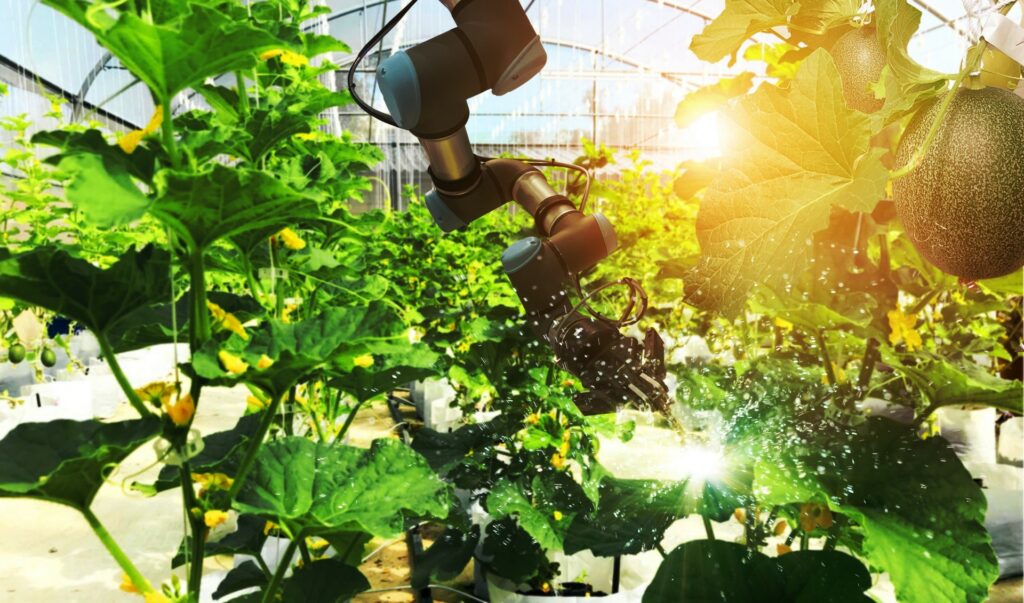Can Artificial Intelligence Replace Essential Pollinators?


Artificial intelligence. Pollinate of fruits and vegetables with robot. Detection spray chemical. Leaf analysis and oliar fertilization. Agriculture farming technology concept.
In recent bee news, it seems technology and computers are becoming more intertwined in pollinators’ lives. Last month, we blogged about Oracle’s incredible technology to assist beekeepers worldwide in staying connected through a network designed to protect hives, food production, and bees from predators using early detection of hive irregularities. It appears now that a startup company in Israel has developed the first commercial artificial intelligence (AI) robot to replicate the bumblebee’s buzz. Its name is Polly. Polly’s specific buzz sends a signal to certain flowers and plants to release pollen. So, the question is: can artificial intelligence replace bumblebees? And, if the answer is yes, should they?
These questions will no doubt create controversy among groups. Still, a few facts that most of the public are unaware of help explain why this company has created AI to alleviate some of the pains associated with pollination.
Bees Can Carry Diseases, but Polly Cannot
Polly is the name of the AI robot designed to replicate the bumblebee buzz designed to signal flowers to release their pollen. Bumblebees in the wild can carry disease to a hive and potentially kill the hive entirely. Being a robot that drives up and down the rows in greenhouses, Polly cannot get sick or carry disease to plants or other pollinators. Polly can increase crop yield compared to bumble production without ever touching the plant. Polly simulates pollination, which has been done previously, but not on a commercial scale.
Artificial Pollination is Not New
Although the first robot for commercial use, Polly is not the first pollination simulator designed and built. Farmers have done manual pollination for years and, in some cases, have used electric toothbrushes for the vibrations to mimic bumblebee’s buzz.
Several organizations are taking bold strides to protect endangered bee species better, and legislation is following in step. However, this startup replicating bumblebee buzzing to force pollen release is approaching new levels in technology replacing nature. Polly creates vibrations that cause pollen to release from flowers, releasing what is needed to produce fruit. The founders that created Polly claim it does the same thing bees do, but with more success, consistency, and reliability.
So far, Polly’s testing has focused on greenhouses using tomato plants. Using AI, production is up five percent above normal bumblebee pollination. As AI compares to manual pollination, Polly yielded up to twenty percent higher. Polly’s efficiency in tomato production leaves a waiting list of clients eager to try.
What Makes Artificial Pollination Valuable
It always comes down to value-added, and if there is a more efficient way to do something for greater yield, most companies do not think twice. Polly not only triggers pollen release but also drives up and down the rows of plants, capturing images of the flowers and identifying those ready to be pollinated.
The robot then sends out pulses replicating the bumblebees’ pollination buzz. In the natural pollination process, the bee’s body vibrates at a specific speed, releases the pollen, and fertilizes the flower.
Tomato producers are delighted with the results and are establishing the use of Polly in greenhouses in Finland, Australia, and North America. Although only working with tomato plants currently, there is no doubt that science will continue to expand Polly’s adaptability to other plants and flowers. The robots are now available for lease with a significant waiting list.
Bees Have Some Limitations Polly Does Not
No Transmission of Disease
Different bee species pollinate other plants, trees, and flowers. Bumblebees are an essential pollinator for tomato plants, which is the market currently utilizing Polly. Bumblebees are at risk of transmitting viruses and are limited in the temperatures in which they work. If it is too hot or cold, bees stay indoors until it is ideal for them to do their work. Bees are also susceptible to pesticides and do not have the same measurable preciseness that Polly offers.
No Labor Limitations
Effective and reliable, AI in pollination is quickly being identified as useful beyond the greenhouse walls. Pollination is the first market but may soon replace humans working manually to pollinate and build resistance against the declining number of bees worldwide. In agriculture, greenhouse farming requires intense labor, often necessary in relentless heat using worn-out equipment.
Using AI to pollinate offers crop producers the benefits of consistency in pollination, increased yield, reduced hazards for labor workers, and no risk of spreading disease among other pollinators or plants. Although technology completely replacing essential pollinators seems unnatural, if together they can create a more resilient ecosystem, it might be worth forging ahead.
If you are a local beekeeper and have concerns with your hive’s health, contact a reputable and excellent local beekeeper. If you have a hive that poses a threat and want it removed, please get in touch with a professional bee removal company to safely move the hive so the bees stay healthy, and you and your family are safe.
